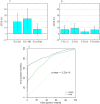Electronic Health Record Driven Prediction for Gestational Diabetes Mellitus in Early Pregnancy
- PMID: 29180800
- PMCID: PMC5703904
- DOI: 10.1038/s41598-017-16665-y
Electronic Health Record Driven Prediction for Gestational Diabetes Mellitus in Early Pregnancy
Abstract
Gestational diabetes mellitus (GDM) is conventionally confirmed with oral glucose tolerance test (OGTT) in 24 to 28 weeks of gestation, but it is still uncertain whether it can be predicted with secondary use of electronic health records (EHRs) in early pregnancy. To this purpose, the cost-sensitive hybrid model (CSHM) and five conventional machine learning methods are used to construct the predictive models, capturing the future risks of GDM in the temporally aggregated EHRs. The experimental data sources from a nested case-control study cohort, containing 33,935 gestational women in West China Second Hospital. After data cleaning, 4,378 cases and 50 attributes are stored and collected for the data set. Through selecting the most feasible method, the cost parameter of CSHM is adapted to deal with imbalance of the dataset. In the experiment, 3940 samples are used for training and the rest 438 samples for testing. Although the accuracy of positive samples is barely acceptable (62.16%), the results suggest that the vast majority (98.4%) of those predicted positive instances are real positives. To our knowledge, this is the first study to apply machine learning models with EHRs to predict GDM, which will facilitate personalized medicine in maternal health management in the future.
Conflict of interest statement
The authors declare that they have no competing interests.
Figures





Similar articles
-
Early Prediction of Gestational Diabetes Mellitus in the Chinese Population via Advanced Machine Learning.J Clin Endocrinol Metab. 2021 Mar 8;106(3):e1191-e1205. doi: 10.1210/clinem/dgaa899. J Clin Endocrinol Metab. 2021. PMID: 33351102 Free PMC article.
-
The clinical usefulness of glucose tolerance testing in gestational diabetes to predict early postpartum diabetes mellitus.Clin Chem Lab Med. 2006;44(1):99-104. doi: 10.1515/CCLM.2006.019. Clin Chem Lab Med. 2006. PMID: 16375594 Clinical Trial.
-
Selective rather than universal screening for gestational diabetes mellitus?Eur J Obstet Gynecol Reprod Biol. 2015 Aug;191:95-100. doi: 10.1016/j.ejogrb.2015.05.003. Epub 2015 May 30. Eur J Obstet Gynecol Reprod Biol. 2015. PMID: 26112365
-
Gestational diabetes mellitus risk score: A practical tool to predict gestational diabetes mellitus risk in Tanzania.Diabetes Res Clin Pract. 2018 Nov;145:130-137. doi: 10.1016/j.diabres.2018.05.001. Epub 2018 May 28. Diabetes Res Clin Pract. 2018. PMID: 29852237 Review.
-
How should we screen for gestational diabetes?Curr Opin Obstet Gynecol. 2014 Apr;26(2):54-60. doi: 10.1097/GCO.0000000000000049. Curr Opin Obstet Gynecol. 2014. PMID: 24614019 Review.
Cited by
-
Algorithmic identification of atypical diabetes in electronic health record (EHR) systems.PLoS One. 2022 Dec 12;17(12):e0278759. doi: 10.1371/journal.pone.0278759. eCollection 2022. PLoS One. 2022. PMID: 36508462 Free PMC article.
-
Machine learning approaches to predict peak demand days of cardiovascular admissions considering environmental exposure.BMC Med Inform Decis Mak. 2020 May 1;20(1):83. doi: 10.1186/s12911-020-1101-8. BMC Med Inform Decis Mak. 2020. PMID: 32357880 Free PMC article.
-
Predicting Prenatal Depression and Assessing Model Bias Using Machine Learning Models.Biol Psychiatry Glob Open Sci. 2024 Aug 14;4(6):100376. doi: 10.1016/j.bpsgos.2024.100376. eCollection 2024 Nov. Biol Psychiatry Glob Open Sci. 2024. PMID: 39399154 Free PMC article.
-
A simple model to predict risk of gestational diabetes mellitus from 8 to 20 weeks of gestation in Chinese women.BMC Pregnancy Childbirth. 2019 Jul 19;19(1):252. doi: 10.1186/s12884-019-2374-8. BMC Pregnancy Childbirth. 2019. PMID: 31324151 Free PMC article.
-
An Evaluation of the Second Trimester Thyroid Function Test in Gestational Diabetes Mellitus: A Case-Control Study.Cureus. 2023 Jul 13;15(7):e41858. doi: 10.7759/cureus.41858. eCollection 2023 Jul. Cureus. 2023. PMID: 37581158 Free PMC article.
References
-
- United Nations. Sustainable development goals: 7 goals to transform our world (Facts and figures) http://www.un.org/sustainabledevelopment/health/ (2017).
-
- Metzger B, Coustan D. Summary and Recommendations of the Fourth International Workshop-Conference on Gestational Diabetes Mellitus. Diabetes Care. 1998;21(Suppl 2):B161. - PubMed
Publication types
MeSH terms
LinkOut - more resources
Full Text Sources
Other Literature Sources
Molecular Biology Databases

